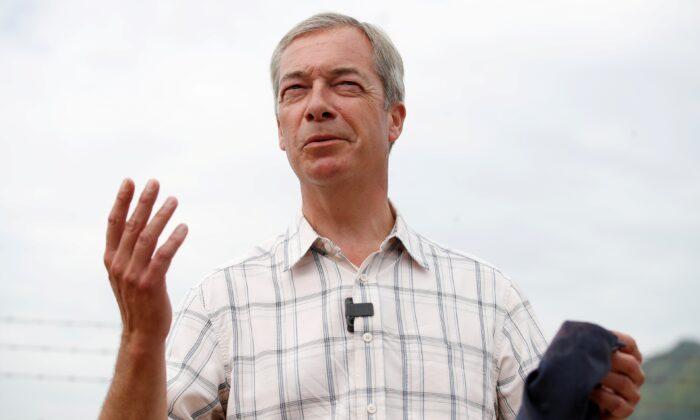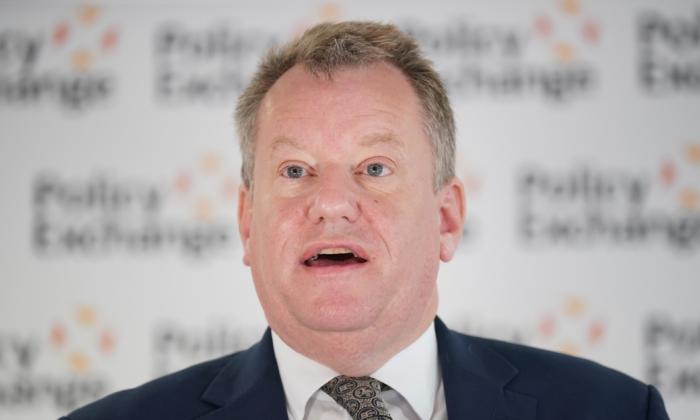The UK economy grew by more than first thought in the fourth quarter of 2022, according to revised official data confirming the country avoided a recession last year.
Economists had previously said the economy saw zero growth between October and December, indicating the UK had very narrowly avoided a recession.
But revised figures released by the Office for National Statistics (ONS) on Friday show that gross domestic product (GDP) increased by 0.1 percent over the quarter.
Though the economy saw a 0.1 percent decline in the third quarter, the latest figures confirm that the UK avoided falling into recession—defined in the UK as two quarters of declining GDP in a row—at the end of 2022.
ONS director of economic statistics Darren Morgan said: “The economy performed a little more strongly in the latter half of last year than previously estimated, with later data showing telecommunications, construction, and manufacturing all faring better than initially thought in the latest quarter.
“Households saved more in the last quarter, with their finances boosted by the government’s energy bill support scheme.
“Meanwhile, the UK’s balance of payments deficit with the rest of the world narrowed, driven by increased foreign earnings by UK companies, particularly in the energy sector.”

‘Positive Surprises’
Philip Shaw, chief economist at Investec, said: “The latest release takes the UK a little further away from the recessionary danger zone, although the report does not change the overall picture that the economy’s performance was lacklustre over the second half of last year as the cost-of-living crisis hit hard.”Martin Beck, chief economic adviser to the EY Item Club, added that the economy is also likely to avoid a recession over the first half of this year.
“Recent economic data has delivered mostly positive surprises, but growth in Q1 faced headwinds from a poor starting point, continued industrial action in some sectors, still-high inflation, and rising interest rates,” he said.
“While some of these adverse forces are now easing, May’s extra bank holiday could exert a drag on output in several sectors, holding back expansion in Q2.
Better Than Expected
This follows predictions from the Bank of England that the UK’s economic growth will be better than it previously thought.The central bank said on March 23 that it now expects UK GDP to increase slightly in the three months from the start of April, reversing an earlier forecast that it would fall by 0.4 percent.
“While subdued overall, activity was holding up better than contacts had previously expected, particularly in the consumer services sector,” the bank said.

The government’s decision to cancel a planned £500 rise in energy bills at the start of April will also help households, the bank said.
“Real household disposable income could remain broadly flat in the near term, rather than falling significantly,” said the MPC.
There was also better news for the country’s jobs market with employment growth in the second quarter likely to be stronger than expected, and a flat rather than a rising unemployment rate.
‘Technical Recession’ Avoided
Earlier this month, the Office for Budget Responsibility (OBR), the UK government’s official economic forecaster, said the UK economy is expected to shrink less than previously expected and will avoid a “technical recession.”But it still forecast a contraction of 0.2 percent this year, though it is a significant improvement on the 1.4 percent shrinkage predicted in November.
The OBR also upgraded its growth forecast for 2024 from 1.3 percent to 1.8 percent, but downgraded predictions for the following years to 2.5 percent in 2025, 2.1 percent in 2026, and 1.9 percent in 2027.
It forecast that inflation in the UK will fall from 10.7 percent in the final quarter of last year to 2.9 percent by the end of 2023, partly owing to the impact of the cost-cutting measures.
The OBR also said that living standards are expected to fall by the largest amount since records began, though the decline is not as bad as had been forecast in November.
The forecaster said real household disposable income per person is expected to fall by a cumulative 5.7 percent over the two financial years 2022–23 and 2023–24.
“While this is 1.4 percentage points less than forecast in November, it would still be the largest two-year fall since records began in 1956–57,” the forecaster said.
The OBR said that the UK’s tax burden is expected to reach a post-war high of 37.7 percent of GDP in 2027–28, the highest since the Second World War.





